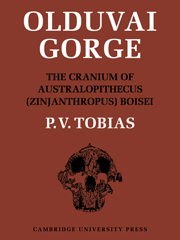Book contents
- Frontmatter
- Contents
- List of text-figures
- List of plates
- List of tables
- Introductory Note
- Foreword
- Editor's Note
- Acknowledgements
- I Introduction
- II Preservation and reconstruction of the cranium
- III The cranial vault
- IV The basis cranii externa
- V Certain critical angles and indices of the cranium
- VI The interior of the calvaria
- VII The thickness of the cranial bones
- VIII The endocranial cast of Zinjanthropus
- IX Metrical characters of the calvaria as a whole
- X The structure of the face
- XI The pneumatisation of the Zinjanthropus cranium
- XII The dental arcade and the palate
- XIII The pattern of dental attrition and occlusion, with comments on enamel hypoplasia
- XIV The size of individual teeth, absolute and relative
- XV The size of the dentition as a whole
- XVI The crown shape index of the teeth
- XVII The morphology of the teeth
- XVIII Summary of cranial and dental features of Zinjanthropus
- XIX The taxonomic status of Zinjanthropus and of the australopithecines in general
- XX The cultural and phylogenetic status of Australopithecus boisei and of the australopithecines in general
- References
- Index of persons
- Index of subjects
- Plate section
X - The structure of the face
Published online by Cambridge University Press: 05 November 2011
- Frontmatter
- Contents
- List of text-figures
- List of plates
- List of tables
- Introductory Note
- Foreword
- Editor's Note
- Acknowledgements
- I Introduction
- II Preservation and reconstruction of the cranium
- III The cranial vault
- IV The basis cranii externa
- V Certain critical angles and indices of the cranium
- VI The interior of the calvaria
- VII The thickness of the cranial bones
- VIII The endocranial cast of Zinjanthropus
- IX Metrical characters of the calvaria as a whole
- X The structure of the face
- XI The pneumatisation of the Zinjanthropus cranium
- XII The dental arcade and the palate
- XIII The pattern of dental attrition and occlusion, with comments on enamel hypoplasia
- XIV The size of individual teeth, absolute and relative
- XV The size of the dentition as a whole
- XVI The crown shape index of the teeth
- XVII The morphology of the teeth
- XVIII Summary of cranial and dental features of Zinjanthropus
- XIX The taxonomic status of Zinjanthropus and of the australopithecines in general
- XX The cultural and phylogenetic status of Australopithecus boisei and of the australopithecines in general
- References
- Index of persons
- Index of subjects
- Plate section
Summary
The supra-orbital torus (Pls. 1 and 15)
Dominating the face is a powerful supra-orbital torus which is far more robust than in any of the australopithecines hitherto discovered. To illustrate this point, the vertical thickness of the torus was measured at the highest point on the orbital margin: the value in Zinjanthropus (13·6 mm. left, 13·7 right) is nearly twice as great as in most specimens of Paranthropus (7·4 in SK 46; 7·2 in SK 847; 7·8 and 5·6 in SK 48), with the exception of SK 52 which approaches the value in Zinjanthropus (12·4). The values in Sts 5 (Australopithecus) are 7·8 and 9·6 mm. The values quoted by Weidenreich (1943, p. 30) for the toral thickness in Homo erectus pekinensis reveal a range in the middle of the orbital margin of 11·5–17·4 mm. (n = 5 crania, 8 sides). If our technique of measuring this vertical thickness of the torus is comparable with his, then three out of five Choukoutien crania have thicker tori even than Zinjanthropus. This is in keeping with the overall robusticity of the cranium of H. erectus, whereas the australopithecine cranium is an essentially gracile one, though with heavy ectocranial embellishments and tori. Again, if the anteroposterior width of the torus be measured from the mid-point of the anterior surface of the upper margin of the orbit (just lateral to the trochlea) to the temporal crest or line behind, the values in millimetres are as shown in the table in the next column.
- Type
- Chapter
- Information
- Olduvai Gorge , pp. 104 - 125Publisher: Cambridge University PressPrint publication year: 1967



